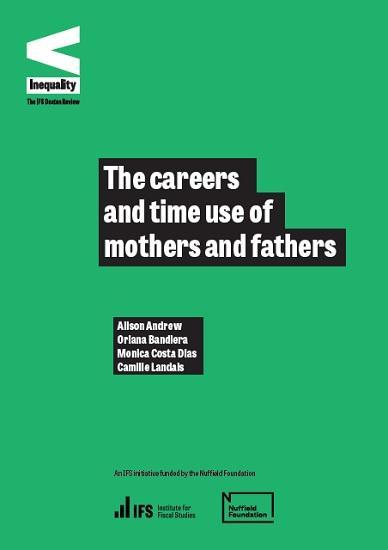The Careers And Time Use Of Mothers And Fathers
12th March 2021

Gender gaps in employment, working hours and wages open up in earnest after workers become parents. At this point, far more mothers than fathers stop paid work or switch to part-time work while taking on the majority of the childcare. This not only results in an instantaneous, mechanical change in the relative personal incomes of mothers and fathers; in slowing the rate at which mothers accumulate career experience relative to fathers, it also has long-lasting, cumulative impacts on the amounts they can earn per hour well into the future. Hence, understanding gender pay gaps hinges crucially on understanding the drivers of changes in working patterns within heterosexual couples upon the arrival of children.
One common claim is that these changes have their roots in (smaller) gender gaps that exist pre-childbirth: perhaps families are maximising their total income while looking after their children, and since - on average - men already have slightly higher hourly wages than women before becoming parents, it makes sense for couples to prioritise men's paid work. This is an important hypothesis: if true, it would imply that the focus for addressing gender gaps in pay should lie largely outside of what happens when people have children - since differences in career trajectories at that point would effectively only be the result of (smaller) differences that were already present beforehand. If false, then instead it makes sense to focus on understanding what happens as families are formed.
In this note, we investigate the evidence, and find no evidence for this hypothesis: the large decline in women's paid work after childbirth cannot, in general, be explained by couples prioritising the paid work of the higher-wage parent. Put most simply, this is because women are always more likely to stop working after parenthood, regardless of whether or not they were the highest earner, and because among those who remain in paid work we see very similar changes in hours of paid work for mothers and fathers regardless of their relative wages before childbirth. Even in families where the mother had a higher wage than the father before the first child arrived, fathers' working patterns are largely unaffected by childbirth whereas mothers reduce their hours of paid work substantially. We supplement this evidence with recent evidence from the COVID-19 crisis, which leads to a similar conclusion: additional childcare needs were met disproportionately by mothers, regardless of whether the mother earned more than the father before the crisis.
This short report is part of the ongoing IFS Deaton Review of Inequalities which will, among many other things, include in-depth studies of the evidence on gender inequalities and how to address them.
Key findings
The average employment and hours of work of men barely change after they become fathers, while the employment of women falls sharply from above 90% to below 75% after childbirth and, amongst those who remain in paid work, hours of work fall from around 40 to less than 30. Further, the wages earned per hour stagnate for working mothers, while continuing to grow uninterrupted for fathers.
Even when women have higher wages than their male partners before childbirth, their employment falls by at least 13% during the first years of parenthood and remains at this lower level for the next decade. Their lower-wage male partners remain in paid work at much higher rates and for longer hours.
During the first coronavirus lockdown - which massively increased the demands on parental time for childcare and domestic work - the division of time in paid work of mothers and fathers in heterosexual couples was consistent with these gendered patterns. Among those parents who worked both before and during the lockdown, mothers who were the higher earner in the couple before the lockdown worked the same number of paid hours during the lockdown as their lower-paid male partners. In contrast, fathers who were the main earner pre-lockdown were working almost double the number of hours as their lower-paid female partners.
The figures are even more striking for uninterrupted working time, which is likely a better measure of time in productive work when that activity is done from home while dividing the space with young children and having to care for them. No matter who was better paid before the lockdown, mothers always did less uninterrupted working time during the confinement period.
These differences in working time were more than compensated by differences in time dedicated to domestic responsibilities, including childcare and housework. Mothers did more of these irrespective of their pre-lockdown relative pay, and they did much more if paid less than their partners. Indeed, lower-paid mothers did double the amount of housework and 41% more childcare than higher-paid fathers, while higher-paid mothers did 6% more housework and 22% more childcare than lower-paid fathers.
Read the report HERE
